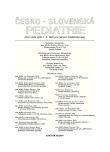Subtelomeric Rearrangement as a Cause of Microcephaly, Facial Dysmorphia and Mental Retardation
Authors:
E. Seemanová; D. Novotná; Z. Vlčková
Authors‘ workplace:
Oddělení klinické genetiky, Ústav biologie a lékařské genetiky, UK 2. LF, Praha
vedoucí MUDr. M. Havlovicová
Published in:
Čes-slov Pediat 2007; 62 (1): 48-51.
Category:
The current Case
Overview
Progress in cytogenetic methods elucidated etiology of 10% mental retardation, microcephaly with multiple anomalies due to detection of subtelomeric rearrangements. The authors report a boy, who was investigated since infancy because of clinical symptoms of Marden-Walker syndrome – severe microcephaly, seizures, blepharophimosis, stenosis of lacrimal ducts, cleft palate, hypospadia, adductal contractures of hips and knees. Only at the age of 10 years, when multiprobe FISH method was introduced to specify genetic prognosis of reproduction for his healthy brothers, the authors were able to identify the subtelomeric deletion of chromosome 8 and telomeric trisomy of chromosome 16 – deletion in subtelomeric area 8p and trisomy in telomeric area 16p, which occurs due to new mutation in proband’s family.
Key words:
congenital microcephaly, blepharoohimosis, palatoschisis, hypospadia, adductal contractures of hip and knees as phenotype of Marden-Walker syndrome due to subtelomeric rearrangement of chromosomes es 8 and 16
Labels
Neonatology Paediatrics General practitioner for children and adolescentsArticle was published in
Czech-Slovak Pediatrics

2007 Issue 1
Most read in this issue
- Mycoplasmal Pneumonia in Childhood
- Stevens–Johnson Syndrome and Toxic Epidermal Necrolysis in Children
- Subtelomeric Rearrangement as a Cause of Microcephaly, Facial Dysmorphia and Mental Retardation
- Problems in Early Establishment of the Diagnosis of Severe Combined Immunodeficiency
